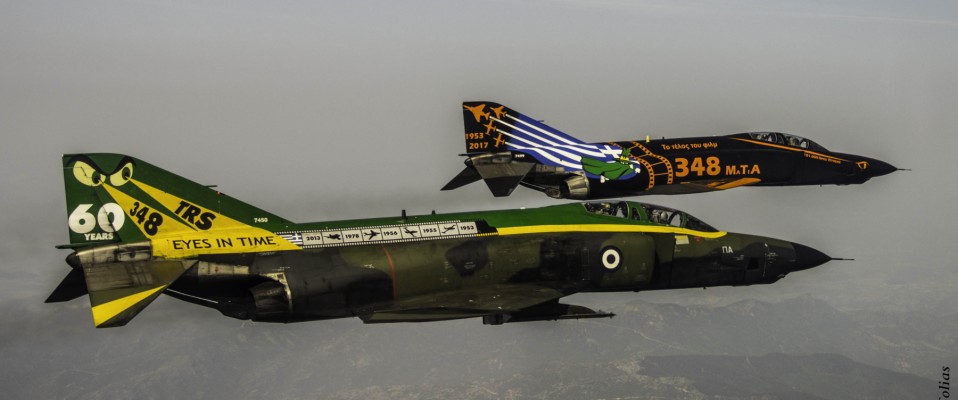Hellenic Air Force: 348 MTA “The End Of The Film”
Last RF-4E Reconnaissance Phantoms in Europe retired
Report and Images by Gabriele Rivera and Adrian Romang
June 4, 2017
This decade has already seen three air forces retiring their Phantoms, partially or fully. The Republic of Korea AF grounded their F-4D in June 2010, followed by Luftwaffe’s F-4F in June 2013, while the USAF retired the QF-4 from service in December 2016 (check APD’s report here). Now was the turn for the Greek RF-4E to grace off and the Πολεμική Αεροπορία (Polemikí Aeroporía, or Hellenic Air Force) wanted to mark this event distinctly.
Thus, an era lasting 64 years came to an official end on Friday, May 5, 2017, when the 348 Tactical Reconnaissance Squadron (Μάτια or Eyes), of the Hellenic Air Force was disbanded at Larissa Air Base. On the same day, the last three flying RF-4E Phantoms in Europe were retired as well, leaving only Japan and Iran operating that type in the reconnaissance role.
To celebrate this long and glorious story, 348 MTA arranged a two-day ceremony. On May 4, more than five hundred Phantom “phans” from 28 countries gathered along Larissa’s taxiway to shoot the last ever pictures of the three remaining RF-4E.
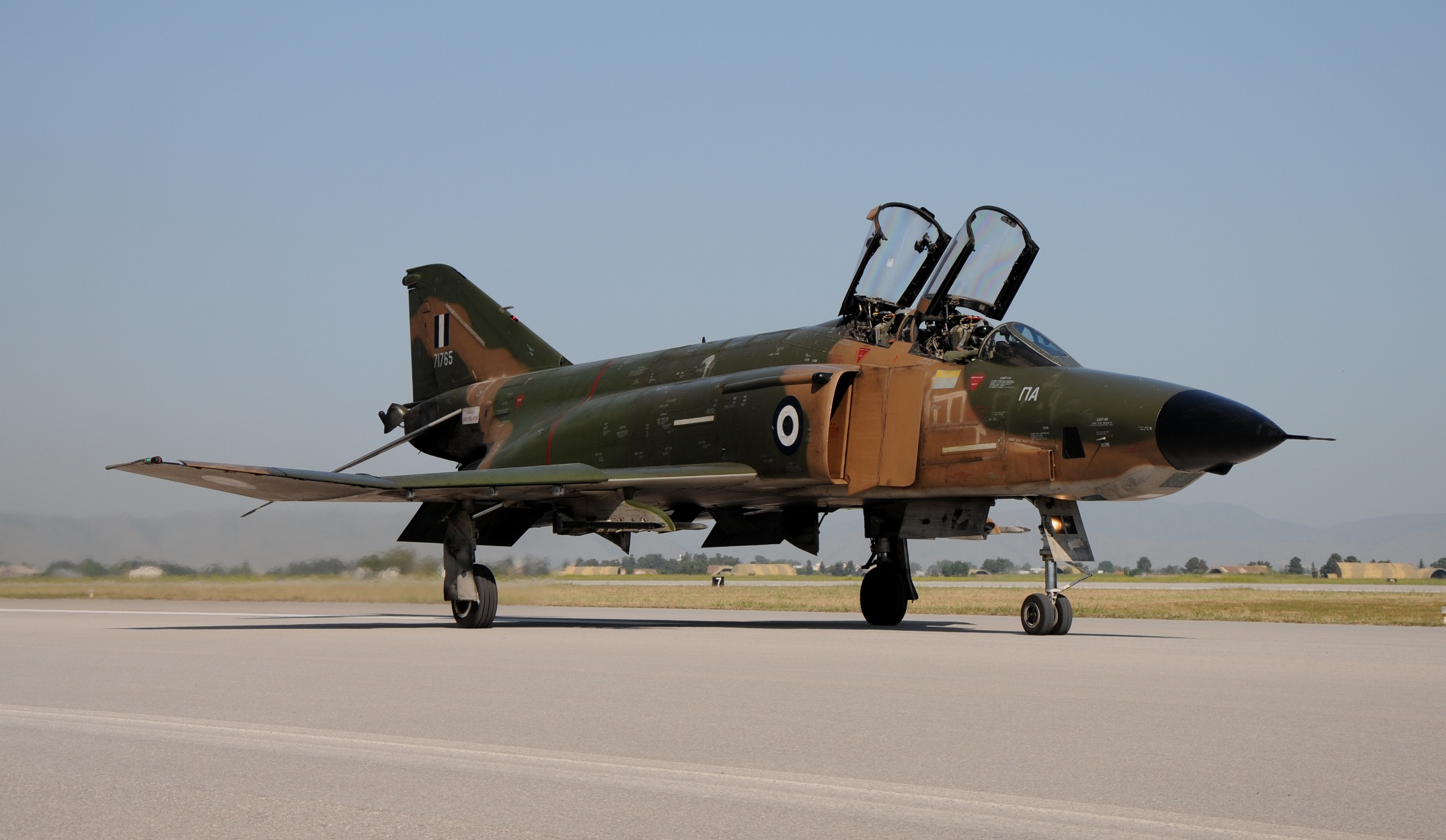
Photo: Adrian Romang
The liveries of two of them were very well known: s/n 71765 was the last one of a U.S. supplied initial batch and still carried the wonderful three tone South East Asia camo schema, while s/n 7450 wore the special livery it got for the Squadron’s 60th anniversary in 2013.
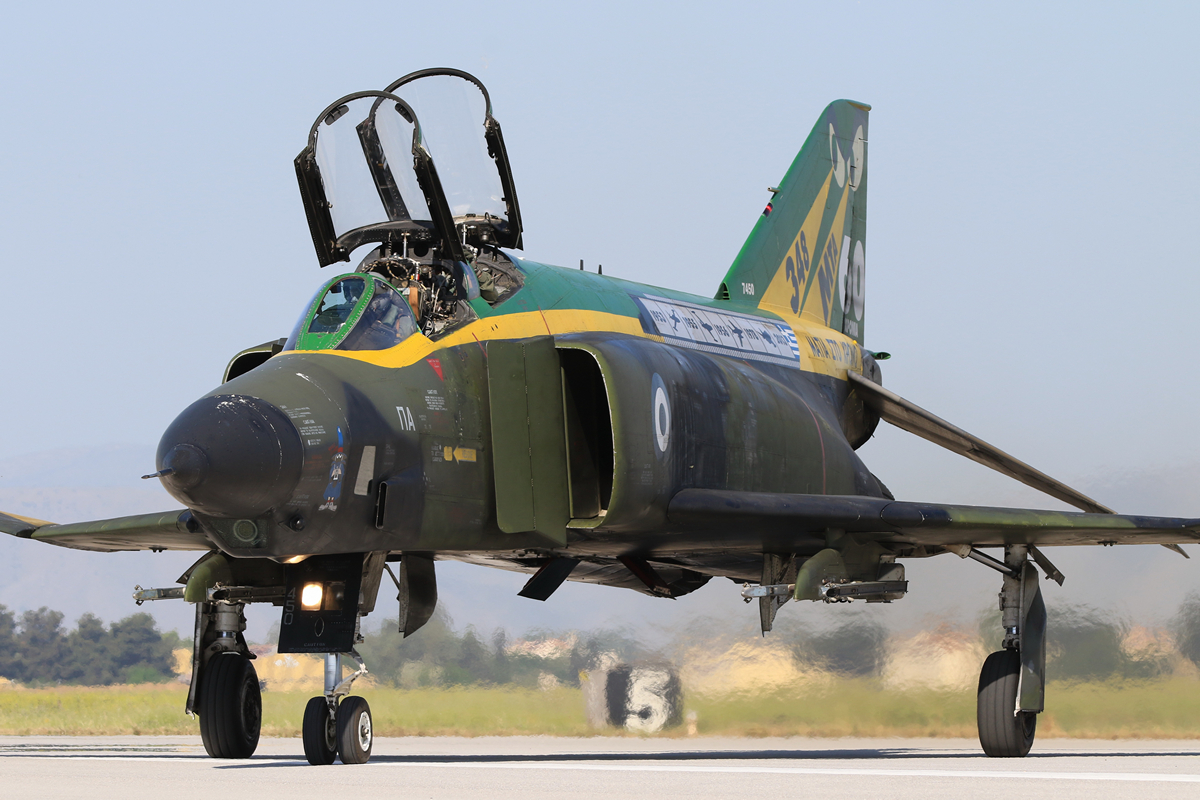
Photo: Gabriele Rivera
Huge expectations lingered among the photographers regarding the new special color of the 3rd Recce Phantom, s/n 7499, the livery of which was applied in honor of the farewell ceremony and was only revealed that day. It turns out that 7499 was actually the very same aircraft the German Air Force chose in 1994 for the Phlyout ceremony of Aufklärungsgeschwader 52 at Leck AB. Back then, the aircraft already had a complete black livery and was christened “Schwarzer Panther” (Black Panther). Its serial in German AF service was 35+52 (ex USAF 69-7499) but this time, the aircraft was a lot more colorful, with the blue-white greek flag and orange text applied giving the aircraft a respectful appearance. Actually, the 348’s complete history has been summed up on the plane’s airframe, with all four aircraft types including hours flown per type and in total between 1953 and 2017 painted on the aircraft. The theme of the event, “The end of the film’, has been a well chosen metaphor merging the decommission of the unit and the transition to a new technology of reconnaissance missions.
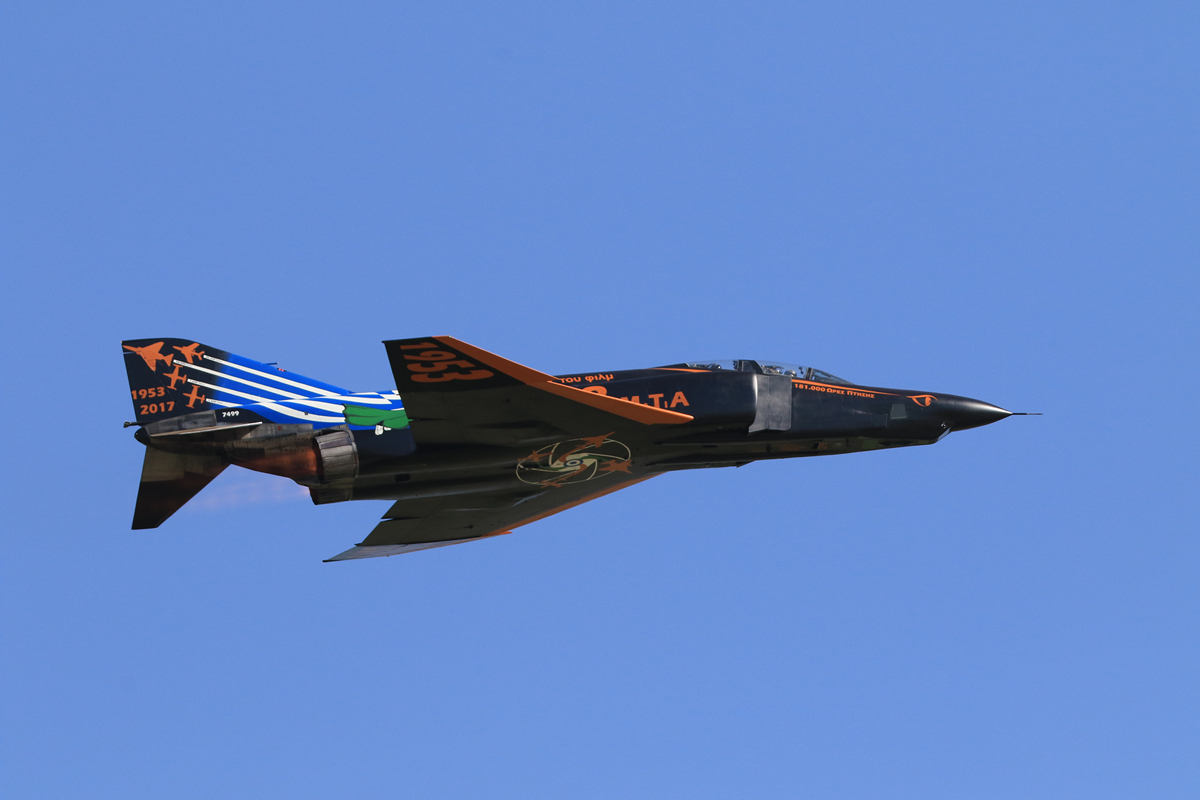
Photo: Gabriele Rivera
In the morning of May 4, the three mentioned RF-4E took off for their very last recce mission, returning after an hour’s flight and then taxi past the crowd gathered to pay tribute to this amazing aircraft, the pilots flying and the ground crews maintaining it.
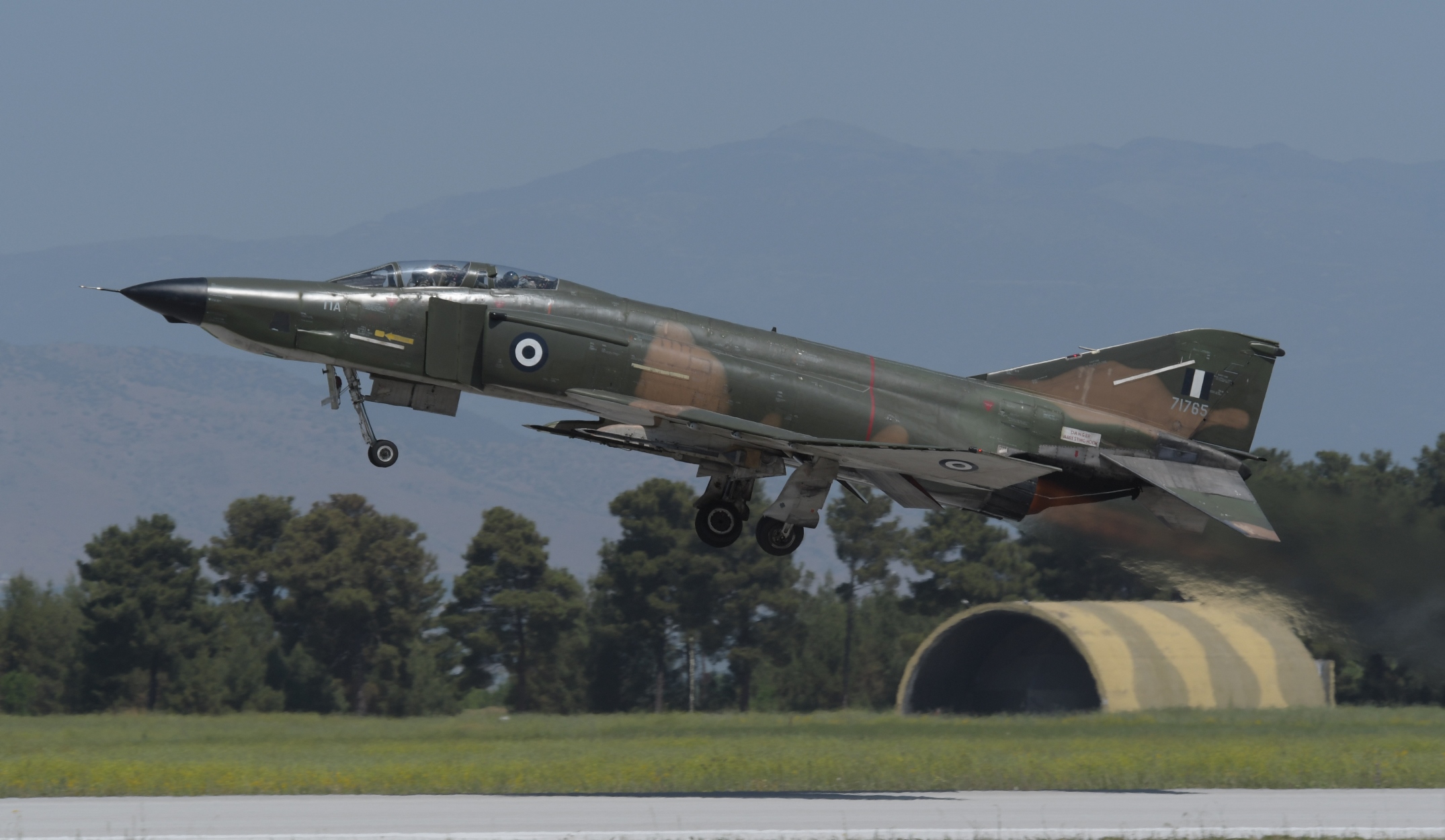
Photo: Adrian Romang
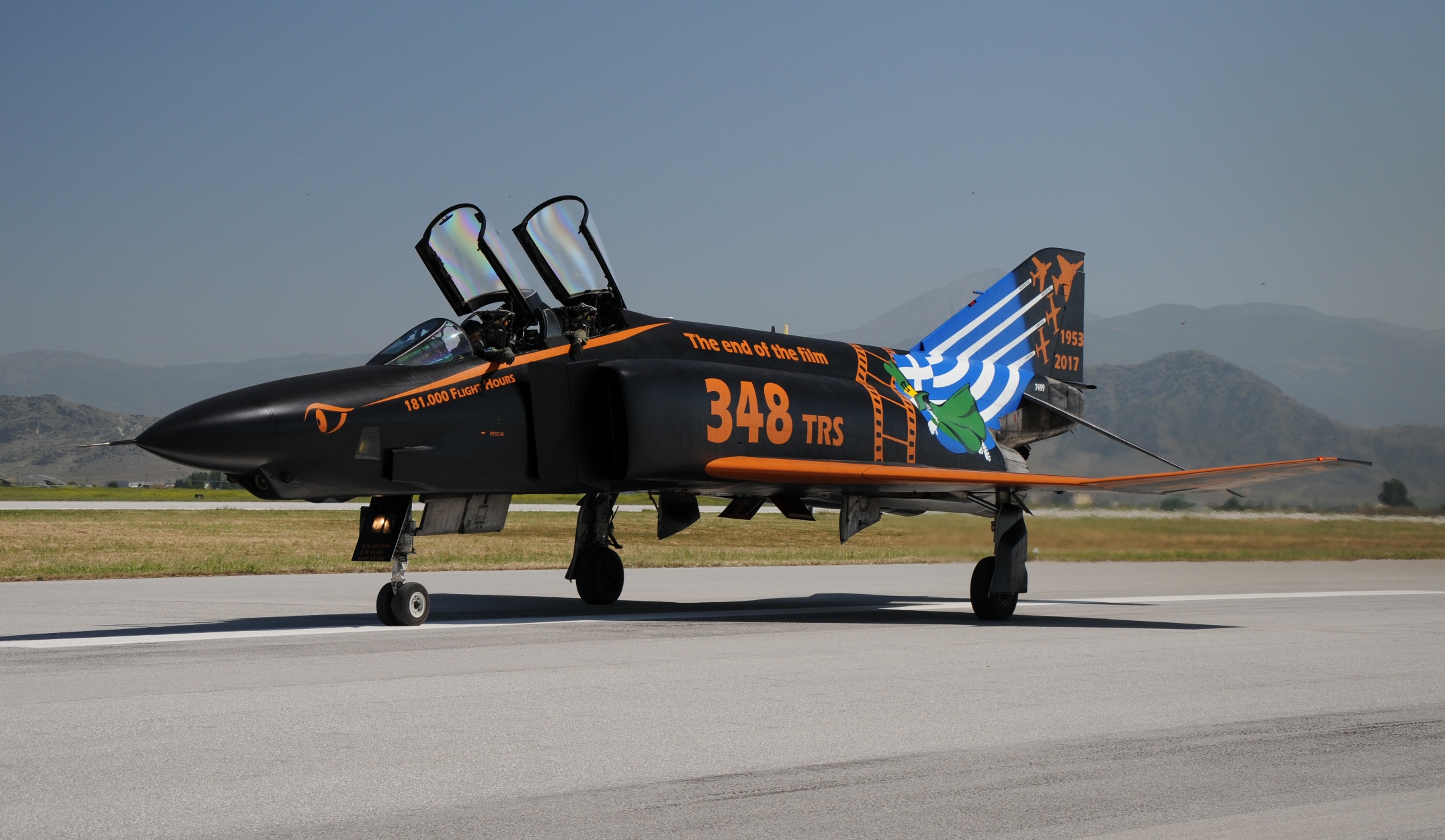
Photo: Adrian Romang
In the afternoon, the attendees were treated with another Phantom wave, with the same three aircraft rehearsing the flight passes for the official ceremony to take place the following day, together with a Mirage 2000EG and an F-16D.
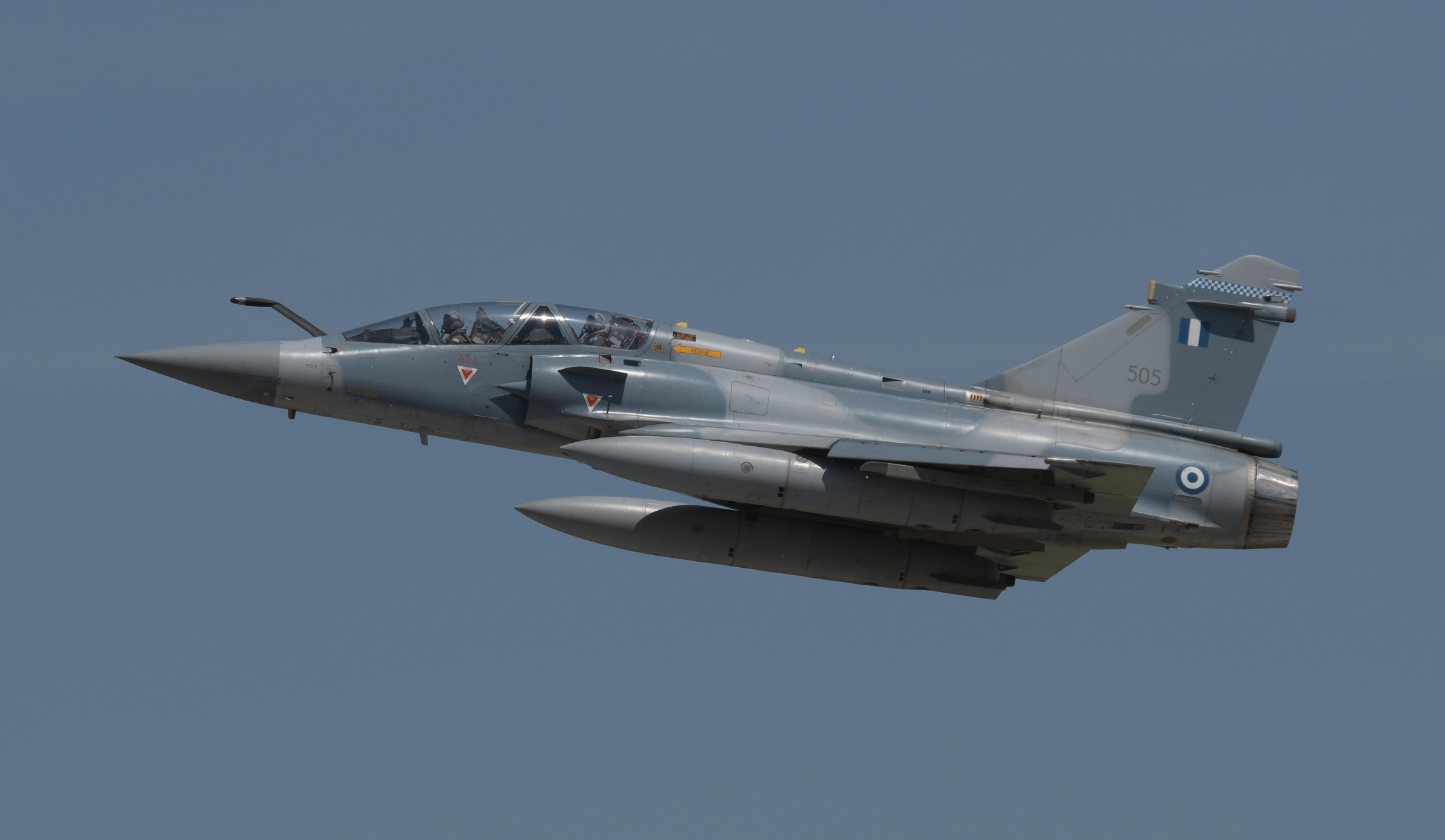
Photo: Adrian Romang
The Zeus and Daedalus demonstration teams (on F-16C Block 52+ and T-6A Texan II respectively) did also run through their aerobatic program.
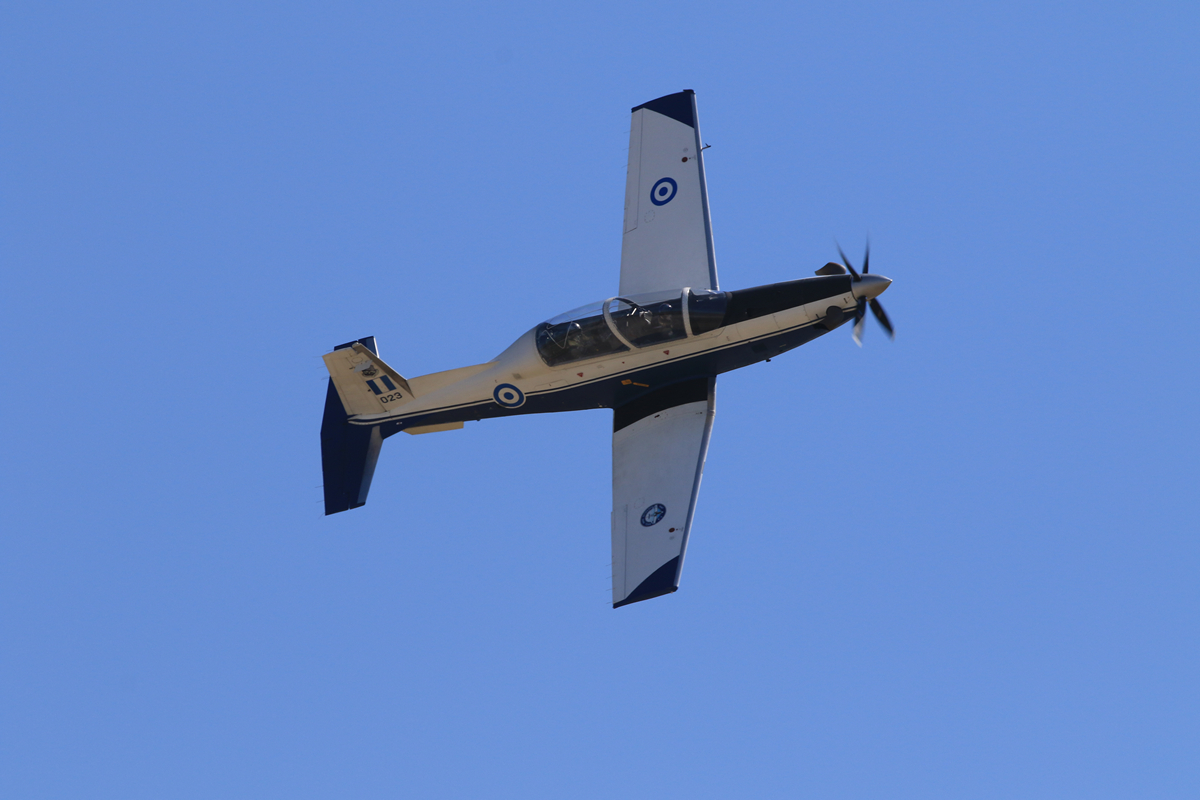
Photo: Gabriele Rivera
A flight of Belgian AF F-16AM spent a few hours on base to pay their homages to the Squadron, while two RAF Tornados from Akrotiri had to cancel their visit due to a severe bird strike. The main thing for the gathered photographers were the three Phantoms though, and their pilots were quite happy to stop every few meters while taxing past us, letting “phans” unleash their shutters to record the last close-up images of those unforgettable machines.
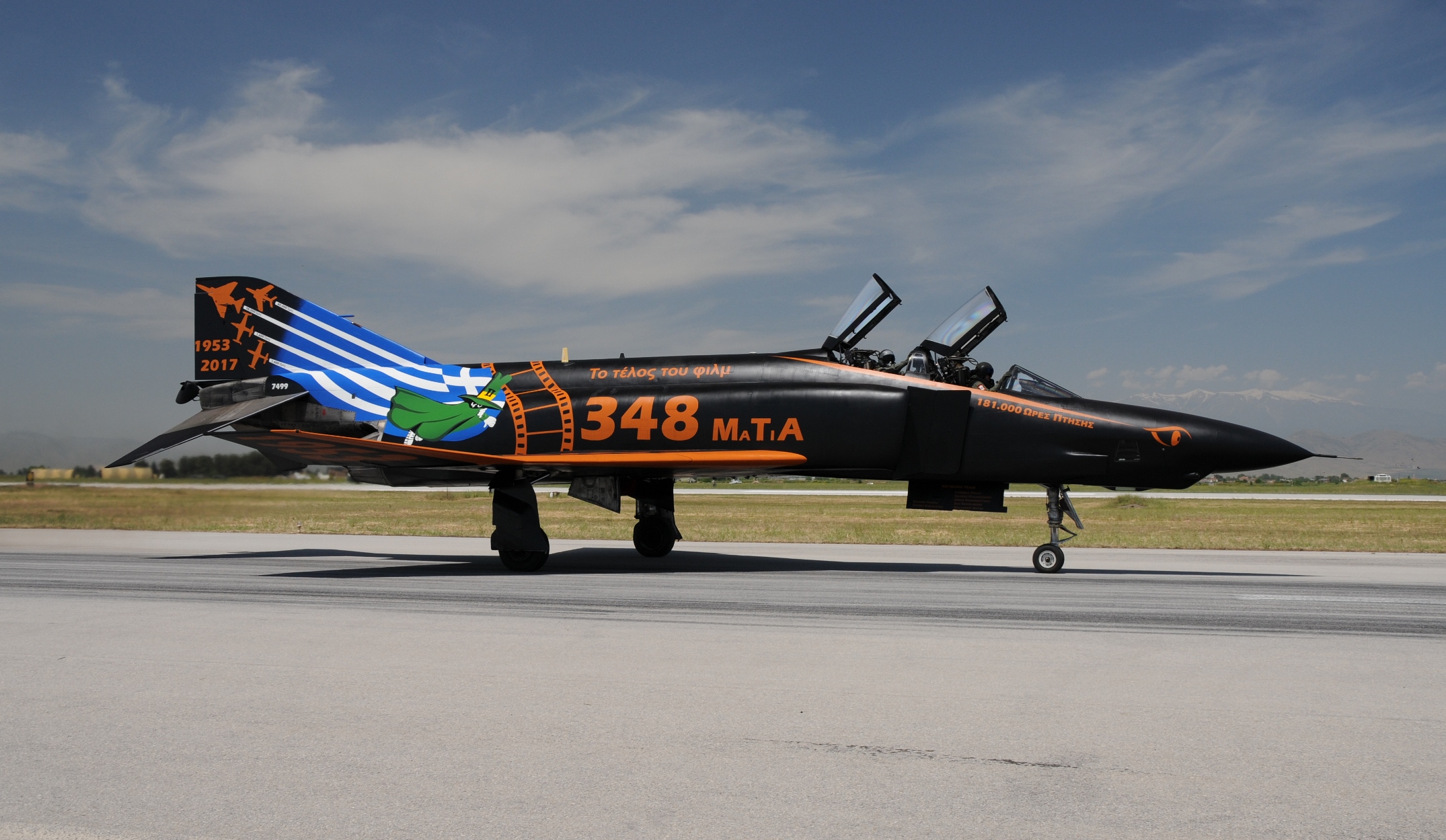
Photo: Adrian Romang
The following day, Friday May 5, exactly 62 years after the 348’s upgrade to Squadron status, the public had the chance to attend the official closing ceremony. It was luckily held under a glorious sun, while snow covered Mount Olympus provided a scenic background. After the speeches of the Chief of the Hellenic Armed Forces, Admiral Evangelos Apostolakis, and the Chief of the Hellenic Air Force General Staff, Lt. General Christos Christodoulou and in the presence of a number of high ranking officials, representatives of the local political, religious communities and public guests, the three Phantoms took off for the official last time to perform some passes escorted by the already mentioned F-16D and Mirage 2000EG. After landing, only the specially painted 7499 taxied to the apron, to be exhibited together with a well-preserved RF-84G Thunderflash and an F-16C Block 52, a visual representation of the history and the future of the HAF recce capability. The ceremony ended after the well appreciated exhibitions of the Zeus and Daedalus demo teams. It was then possible to visit in a nearby hangar a small but interesting exhibition of the hardware used in reconnaissance missions and the result of those flights. Several panels displaying hundreds of pictures related to the activities and the results achieved from 348 MTA during its 64 years of service.
History of 348 TRS
The 348 MTA (Mira Taktikis Anagnoriseos – Tactical Reconnaissance Squadron) was established on November 26th 1953 at Eleusis as a Flight, operating as part of 112 PM (Pteriga Machis, Combat Wing), equipped with nine F-84G Thunderjets whose downward looking cameras were installed in the front section of the left wingtip tanks. In the summer of 1954 the Flight redeployed to Larissa, transitioning from 112 PM to 110 PM, and the following year, on May 5th 1955, it was upgraded to Squadron. By then, the first Thunderjets started to be retired and where replaced by twenty-one RT33-A, a clear improvement of the recce capabilities for the HAF. The RT-33-A fleet was, like the F-84G Thunderjets, only in service for some two years and was already withdrawn from use in 1957, after having flown some 1600 hrs by then.
In August 1956 the first RF-84F Thunderflash was delivered to the Squadron, and it took one year to replace all Lockheed RT-33 planes with the new Republic ones; the new aircraft played a significant role in the recce missions, totaling over 80,000 flight hours over its 35 years of service – a real work-horse! Besides flying over hostile countries like Albania, Bulgaria and Yugoslavia, the RF-84F had been intensively used to map the entire national territory, helping to complete and improve the overall mapping of Greece and to thwart abusive building.
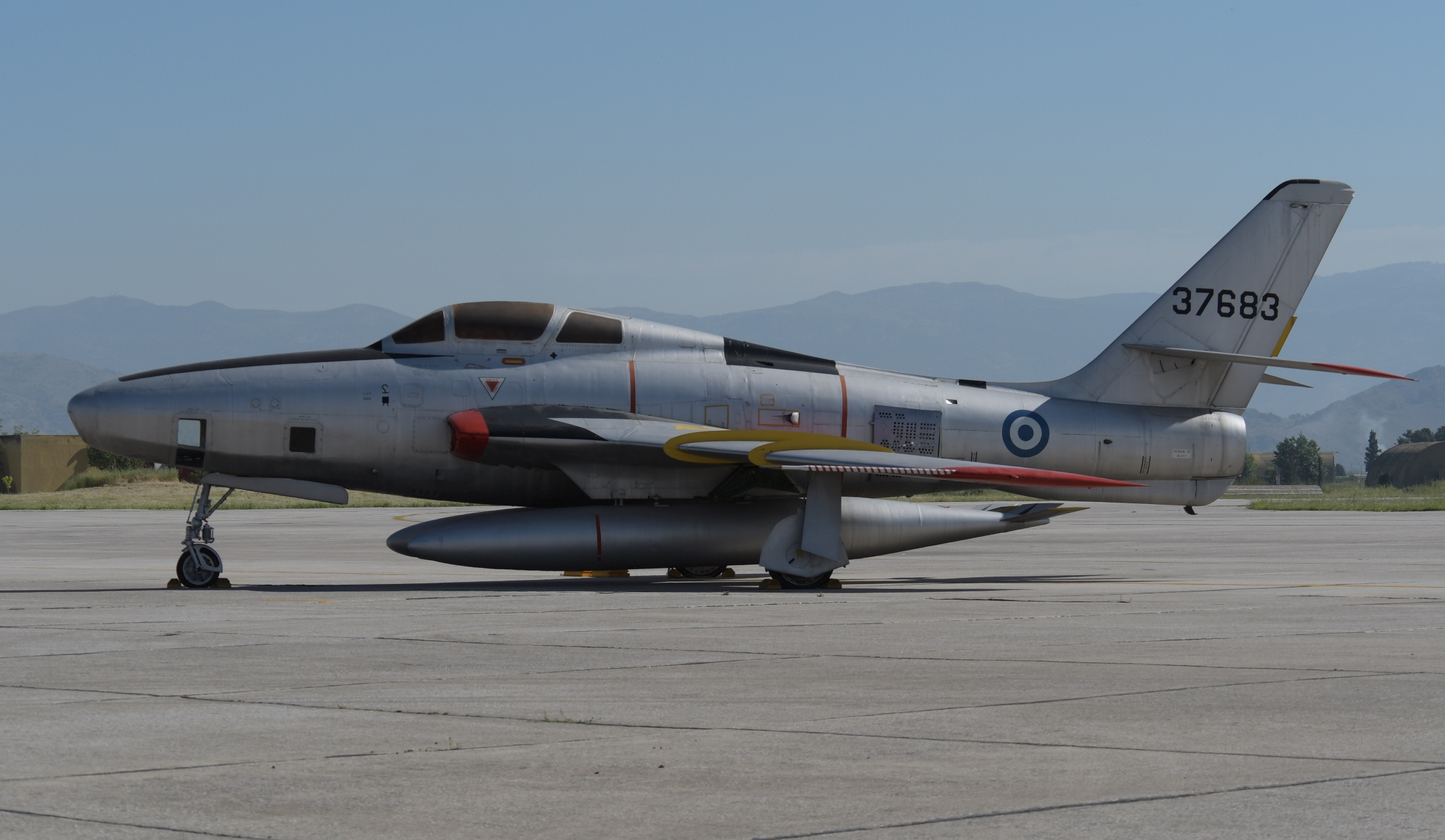
Photo: Adrian Romang
After the entry into service of the McDonnell-Douglas F-4E Phantom II in 1974, the need to replace the aging Thunderflash was already a matter of fact, so a batch of six new built RF-4E was included in the Peace Icarus II program, with the first being delivered on November 3rd, 1978. Besides those initial six aircraft, another two planes were soon after delivered under the Military Assistance Program. Of those eight originally delivered, only one “made it” all the way to May 5, 2017, serial 71765 already mentioned above.
The introduction of the new airplane brought consistent advantages; bisonic flight, stand-off capabilities thanks to the adoption of the LOROP technique (Long Range Oblique Photography), which allowed taking hi-res pictures using the KS-127A camera with a focal length of 66 inches, while flying some 30 miles from the target. The AN/AAD-5 system was used to obtain infra-red images.
The eight Phantoms formed a new independent Squadron under the direct command of 110 PM (Combat Wing). The first task was to train and convert pilots with considerable experience on the Thunderflash or other legacy aircraft to the RF-4E, and then to develop new tactics in order to exploit the potential of these powerful machines to their fullest extent. During these years the Squadron hosted American instructors several times, whose task was to share with their Greek colleagues the “lesson learned” during the operations theatre in the Far East.
In July of 1987, almost nine years after the first Phantom landed in Larissa, the two Recce Squadrons (348 MTA with RF-84F and the independent sibling with RF-4E) were merged into just one unit, flying both Recce models over the next four years. In March 1991 the venerable RF-84F was retired from active duty, having gloriously served for 35 years.
Meanwhile the initial eight Recce Phantoms were reduced to five; three planes had been written off in accidents in 1979, 1985 and 1987. So, in May 1993, the chance to receive 27 ex Luftwaffe RF-4E was a welcomed boost. After being thoroughly inspected by HAF technicians, twenty of them went to swell the flightline of 348 MTA, while the remaining seven became the source of spare parts.
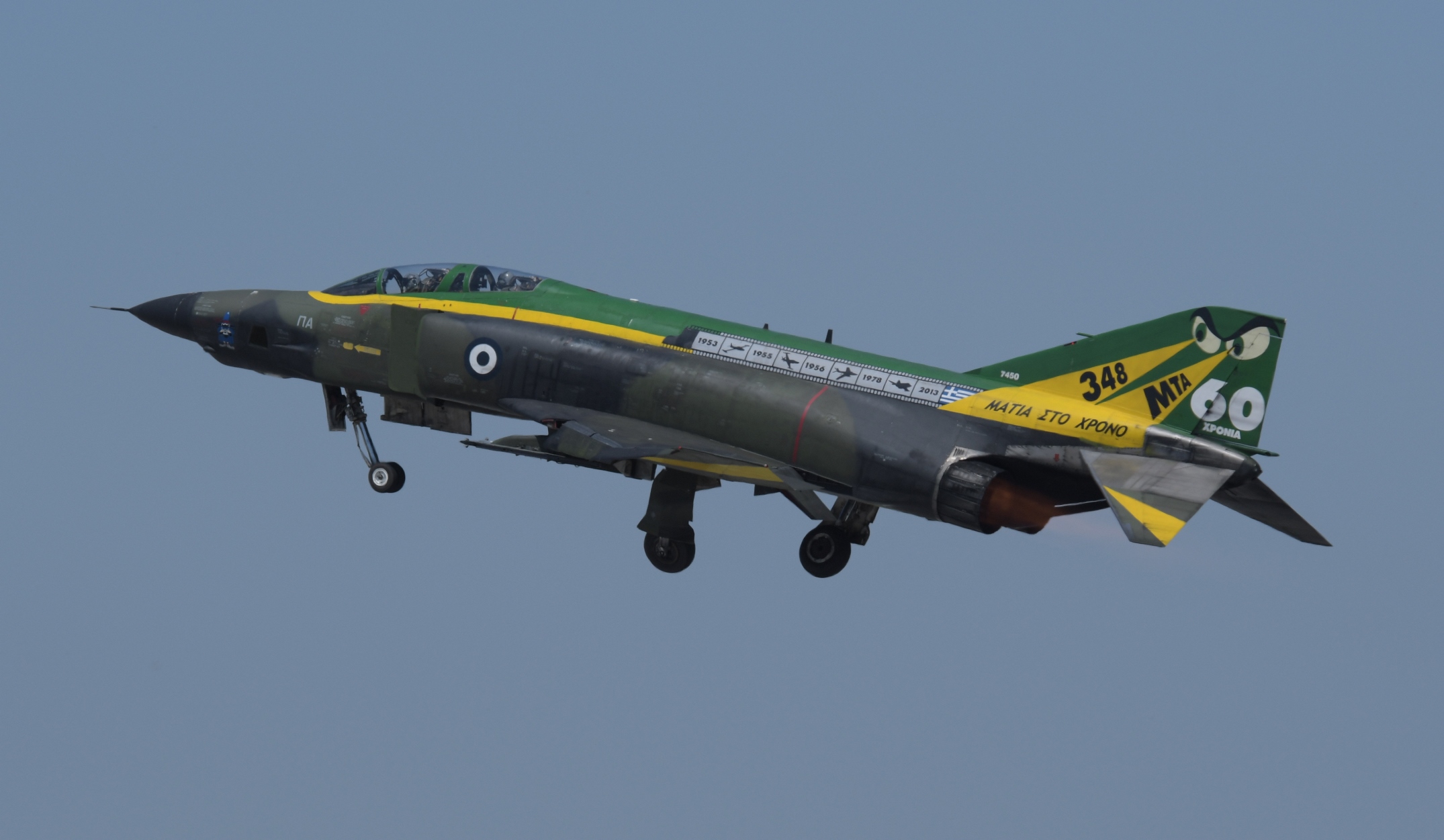
Photo: Adrian Romang
The German Phantoms were of previous production blocks (43 up to 47), while the initial American batch were of Block 66; they had no RWR (radar warning receivers) and couldn’t be equipped with Sidewinder missiles. Their older wings allowed Angle of Attack (AoA) maneuvers of 19.2° versus 25° for the newer design, but were more stable in low level flight, obviously an advantage for recce missions. Moreover, the flight combinations for the pilots weren’t compatible with the ones worn to fly with the block 66 ships.
| Model | USAF | German AF | HAF | remarks |
|---|---|---|---|---|
| RF-4E-43-MC Phantom | 69-7449 | 35+02 | 7449 | ex German AF, to HAF 1993, w/o 25-Apr-2006 |
| RF-4E-43-MC Phantom | 69-7450 | 35+03 | 7450 | ex German AF, to HAF 1993, special 60 yrs 348 MTA livery, retired 5-May-2017 |
| RF-4E-43-MC Phantom | 69-7454 | 35+07 | -7454 | ex German AF, to HAF as spare, std Larissa |
| RF-4E-44-MC Phantom | 69-7460 | 35+13 | -7460 | ex German AF, to HAF as spare, std Larissa |
| RF-4E-45-MC Phantom | 69-7464 | 35+17 | 7464 | ex German AF, to HAF 1993 |
| RF-4E-45-MC Phantom | 69-7471 | 35+24 | -7471 | ex German AF, to HAF as spare, std Larissa |
| RF-4E-45-MC Phantom | 69-7476 | 35+29 | 7476 | ex German AF, to HAF 1993 |
| RF-4E-47-MC Phantom | 69-7482 | 35+35 | 7482 | ex German AF, to HAF 1993 |
| RF-4E-47-MC Phantom | 69-7486 | 35+39 | 7486 | ex German AF, to HAF 1993 |
| RF-4E-47-MC Phantom | 69-7487 | 35+40 | 7487 | ex German AF, to HAF 1993 |
| RF-4E-47-MC Phantom | 69-7491 | 35+44 | 7491 | ex German AF, to HAF 1993 |
| RF-4E-47-MC Phantom | 69-7493 | 35+46 | -7493 | ex German AF, to HAF as spare, std Larissa |
| RF-4E-47-MC Phantom | 69-7495 | 35+48 | 7495 | ex German AF, to HAF 1993 |
| RF-4E-47-MC Phantom | 69-7496 | 35+49 | 7496 | ex German AF, to HAF 1993 |
| RF-4E-47-MC Phantom | 69-7498 | 35+51 | -7498 | ex German AF, to HAF as spare, std Larissa |
| RF-4E-47-MC Phantom | 69-7499 | 35+52 | 7499 | ex German AF,to HAF 1993, "The end of the film" 64 yrs livery, retired 5-May-2017 |
| RF-4E-47-MC Phantom | 69-7500 | 35+53 | 7500 | ex German AF, to HAF 1993 |
| RF-4E-47-MC Phantom | 69-7506 | 35+59 | 7506 | ex German AF, to HAF 1993 |
| RF-4E-47-MC Phantom | 69-7507 | 35+60 | 7507 | ex German AF, to HAF 1993 |
| RF-4E-47-MC Phantom | 69-7508 | 35+61 | 7508 | ex German AF, to HAF 1993 |
| RF-4E-47-MC Phantom | 69-7511 | 35+64 | 7511 | ex German AF, to HAF 1993 |
| RF-4E-47-MC Phantom | 69-7519 | 35+72 | 7519 | ex German AF, to HAF 1993 |
| RF-4E-47-MC Phantom | 69-7529 | 35+82 | 7529 | ex German AF, to HAF 1993 |
| RF-4E-47-MC Phantom | 69-7531 | 35+84 | -7531 | ex German AF,to HAF as spare, std Larissa |
| RF-4E-47-MC Phantom | 69-7533 | 35+86 | 7533 | ex German AF, to HAF 1993 |
| RF-4E-47-MC Phantom | 69-7534 | 35+87 | -7534 | ex German AF,to HAF as spare, std Larissa |
| RF-4E-47-MC Phantom | 69-7535 | 35+88 | 7535 | ex German AF,to HAF 1993 |
| RF-4E-66-MC Phantom | 77-0357 | N/A | 70357 | new builds, 1978-79, w/o 10-Dec-1979 |
| RF-4E-66-MC Phantom | 77-0358 | N/A | 70358 | new builds, 1978-79, w/o 11-Jul-1985 |
| RF-4E-66-MC Phantom | 77-1761 | N/A | 71761 | new builds, 1978-79, w/o 7-May-1987 |
| RF-4E-66-MC Phantom | 77-1762 | N/A | 71762 | new builds, 1978-79, std Larissa |
| RF-4E-66-MC Phantom | 77-1763 | N/A | 71763 | new builds, 1978-79, w/o 6-Jun-2008 |
| RF-4E-66-MC Phantom | 77-1764 | N/A | 71764 | new builds, 1978-79, std Larissa |
| RF-4E-66-MC Phantom | 77-1765 | N/A | 71765 | new builds, 1978-79, retired 5-May-2017 |
| RF-4E-66-MC Phantom | 77-1766 | N/A | 71766 | new builds, 1978-79, w/o 27-Dec-1995 |
In 2003, a new mission was assigned to 348 MTA: SIGINT (SIGnal INTelligence). The Thomson CSF ASTAC (Analyseur de Signaux TACtiques, Tactical Radar Signal Interceptor and Analyzer) pod was added to the panoply of recce tools for the Phantoms, allowing to obtain an enemy’s Electronic Order of Battle scanning and locating the position of emitters in ranges up to 500 miles.
Recce missions are among the most demanding, dangerous and risky missions flown. Unfortunately, over the course of 348 TRS 64 years of active duty, twelve HAF airmen lost their lives. One pilot lost his life while flying a RT-33A, seven men in RF-84F Thunderflash and four in RF-4E accidents. Those 12 men were remembered and honored in a silent moment during the ceremony on May 5.
348 MTA aircraft spent a total of 181’000 hours in the air, of which more than half, some 98’000 flight hours, were carried out by the RF-4E Phantom fleet alone (23’000 hrs out of this total have been flown by the last three remaining Phantoms). An incredible number and it should not be forgotten that all this would not have been possible without many more working hours maintainers and technicians spent on the airframes, engines and equipment. “The RF-4E was a complex jet and access to it’s systems quite demanding. The two basic qualities ground crews should have (had) was will and patience”, explains Major Georgios Katsaros, the last Chief Maintenance Officer of 348 TRS. “The relationship with the Phantom was one of love and respect. If you looked after the Phantom, it did never let you down”. Therefore, a big tribute does not only go to the air crews and those giving their lives, but also to the many ground crews working countless hours on the different recce aircraft types.
The Future
According to unofficial sources, two of the three remaining RF-4E’s took off again for the very final flight on May 10: s/n 7450 bound to Tanagra and s/n 71765 to Andravida, leaving s/n 7499 at it’s home base Larissa. The end of a chapter…..and yet, Recce missions continue.
Indeed, Recce Phantom “phly-outs” mark the end of wet-film recce technology, whose pictures can only be developed after landing, but they also mark the beginning of the latest state-of-the-art hardware. Having said this, HAF recce operations will from now on be performed by Lockheed Martin F-16Cs assigned to 335 Mira based at Araxos, carrying the UTC Aerospace Systems DB-110 day/night reconnaissance pod.
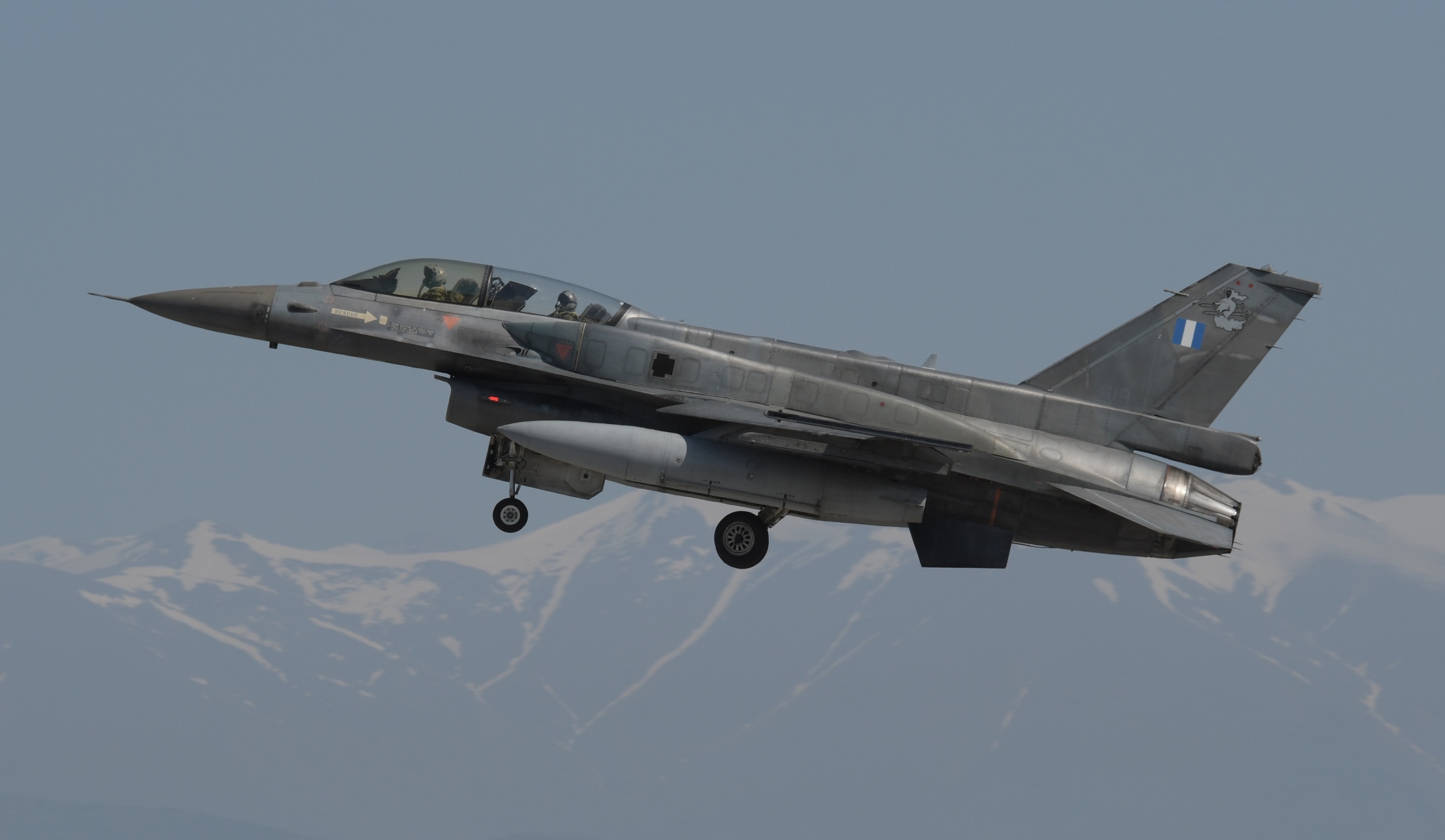
Photo: Adrian Romang
The authors want to thank Lt Col Ioannis Tsitoumis (HAF Spokesperson), Major Lambros Tolias, Captain George Poimenidis, Captain Achilles Michalopoulos, Mr Sotos Kakaletris and all their colleagues involved in the organization of this historic event.
Featured Image: Photo copyright by Hellenic Air Force / Major Lambros Tolias (used with permission)
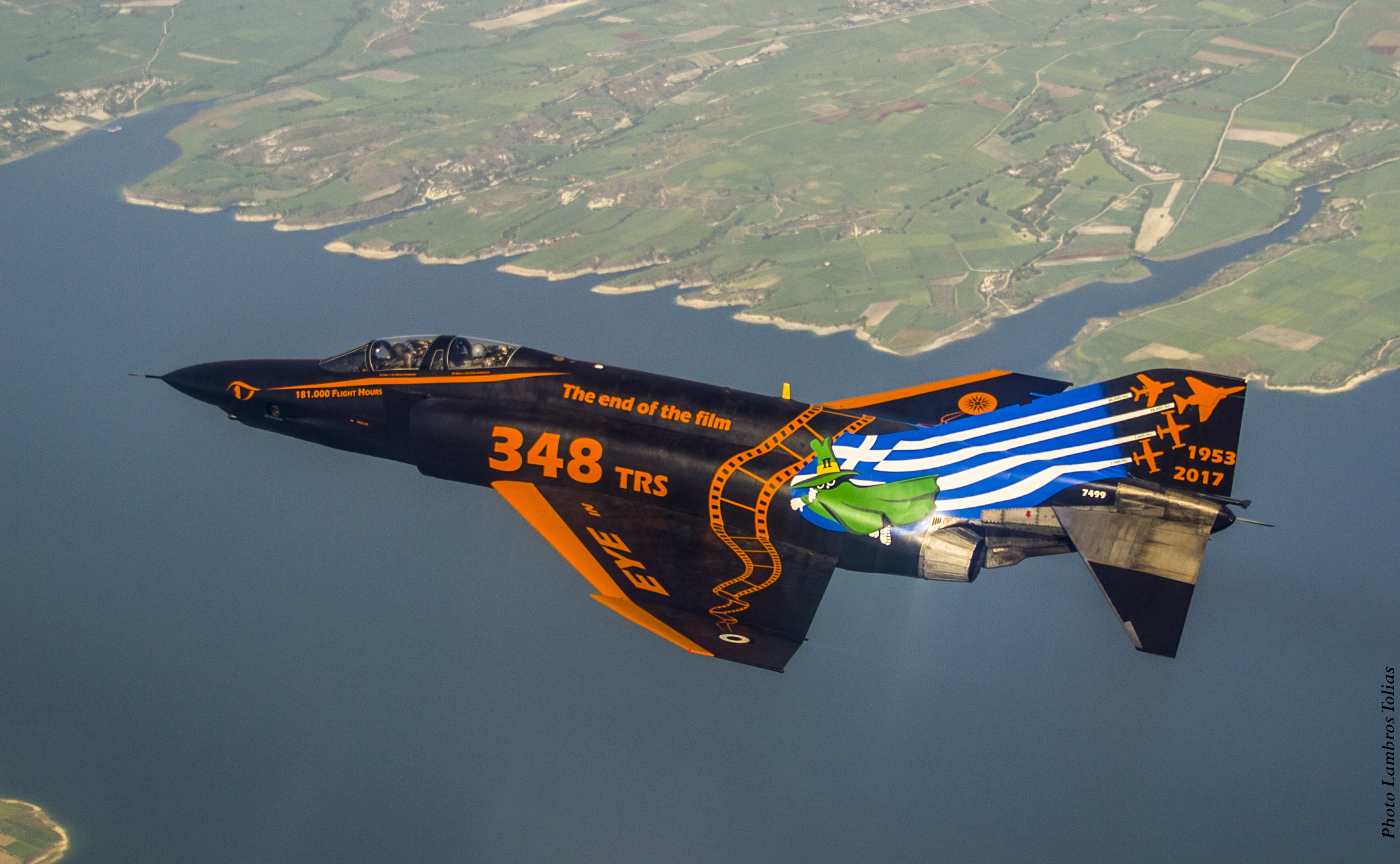
Photo copyright by Hellenic Air Force / Major Lambros Tolias (used with permission)
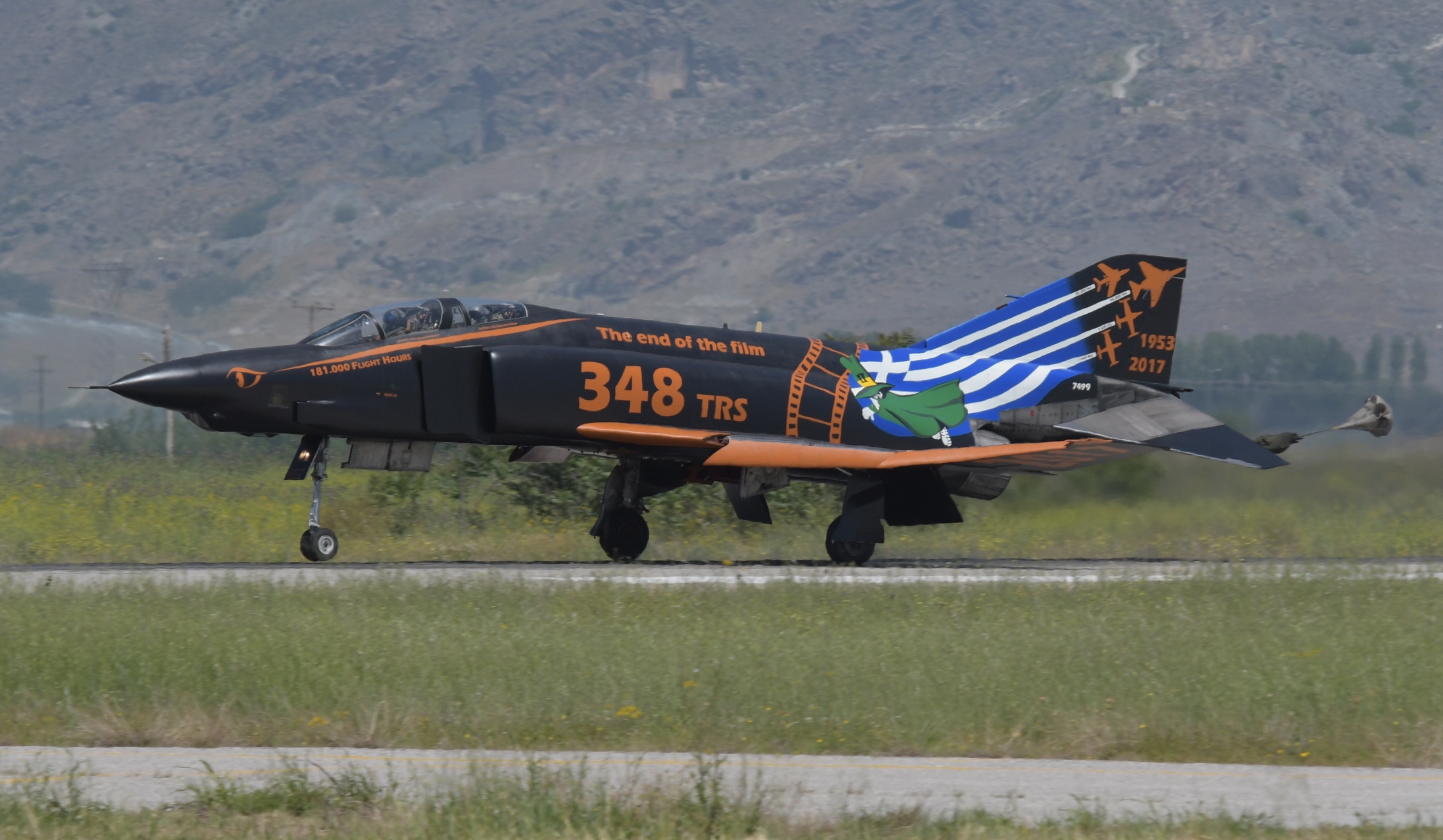
Photo: Adrian Romang
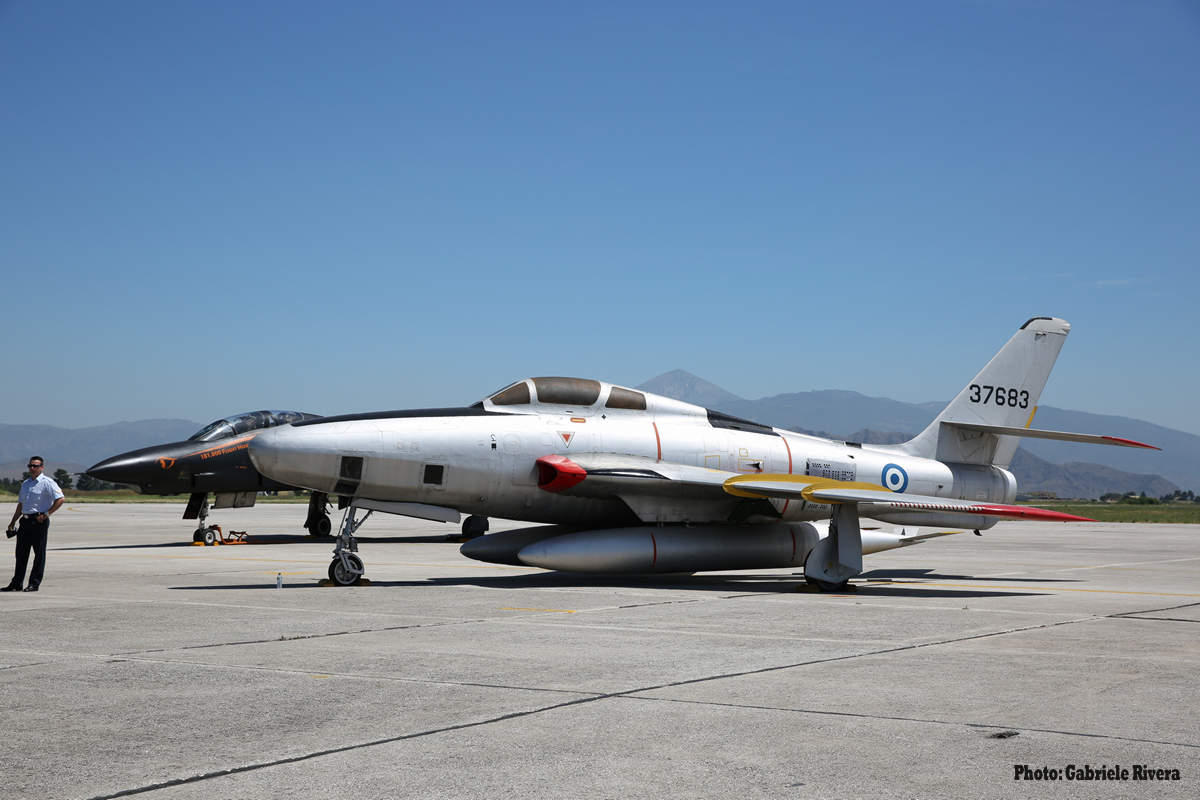
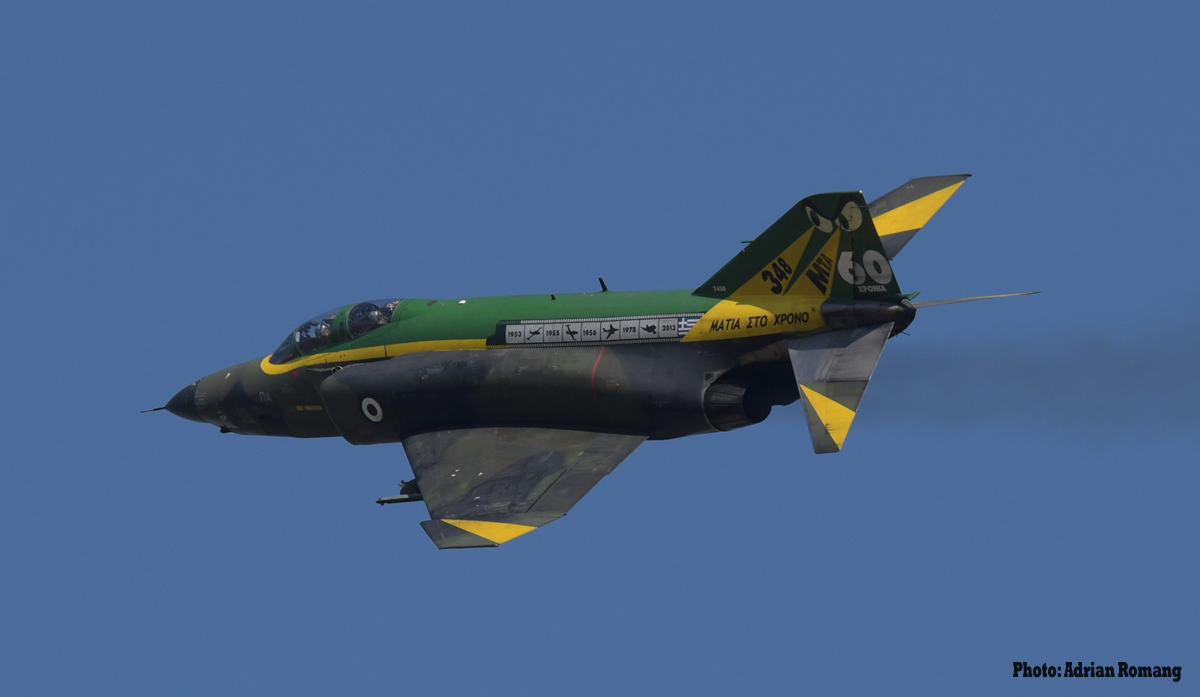
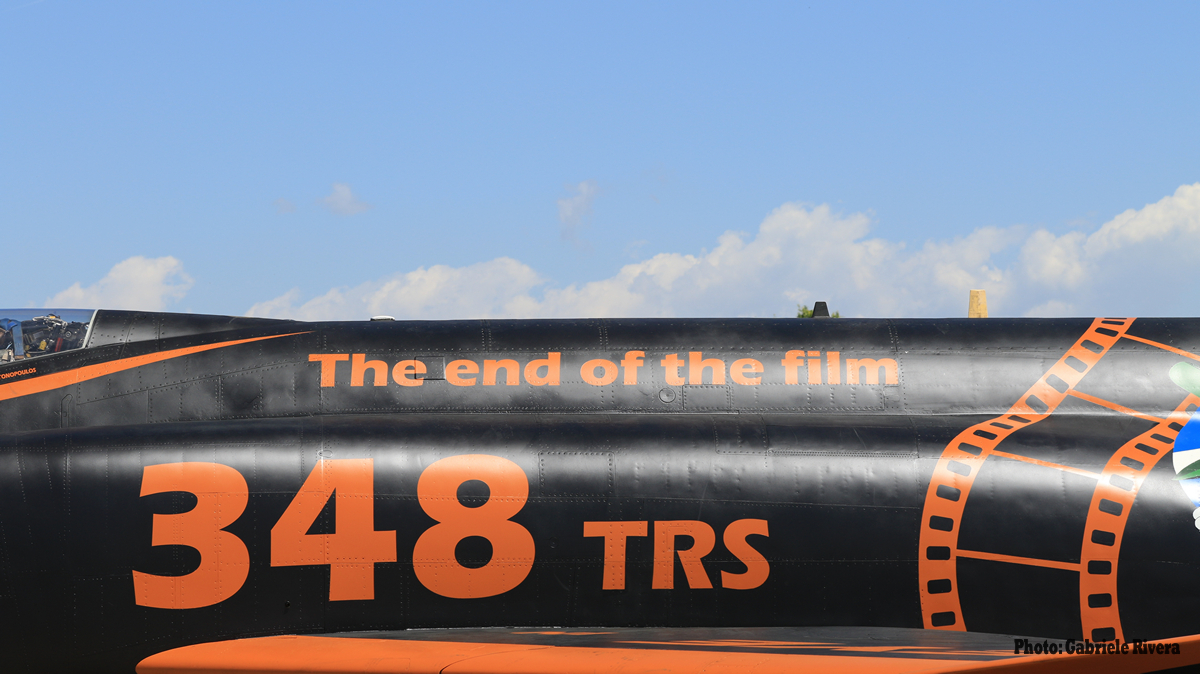
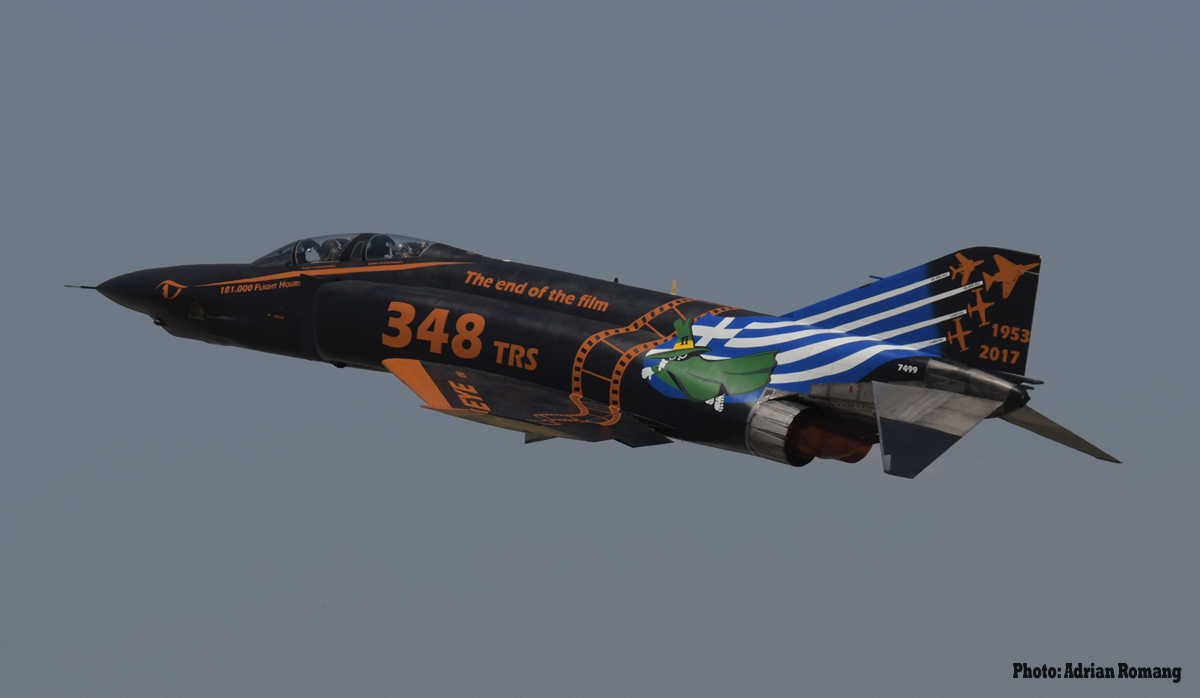
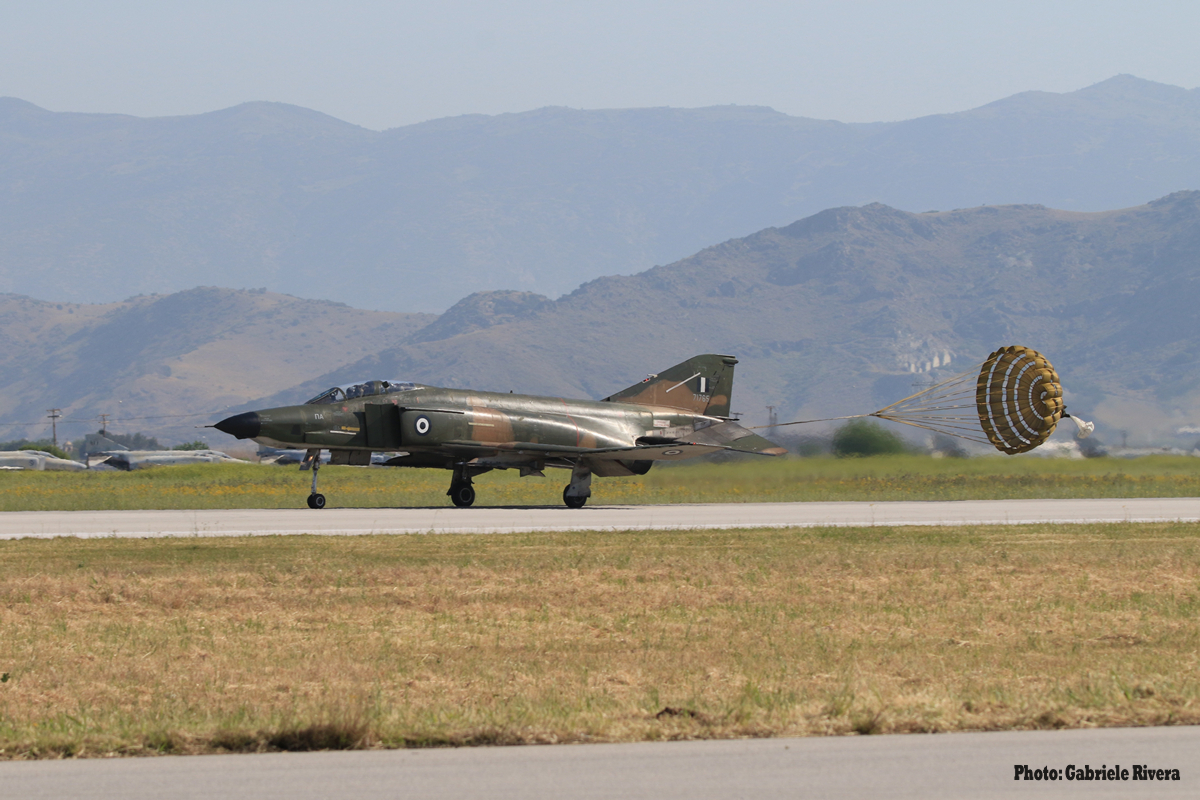
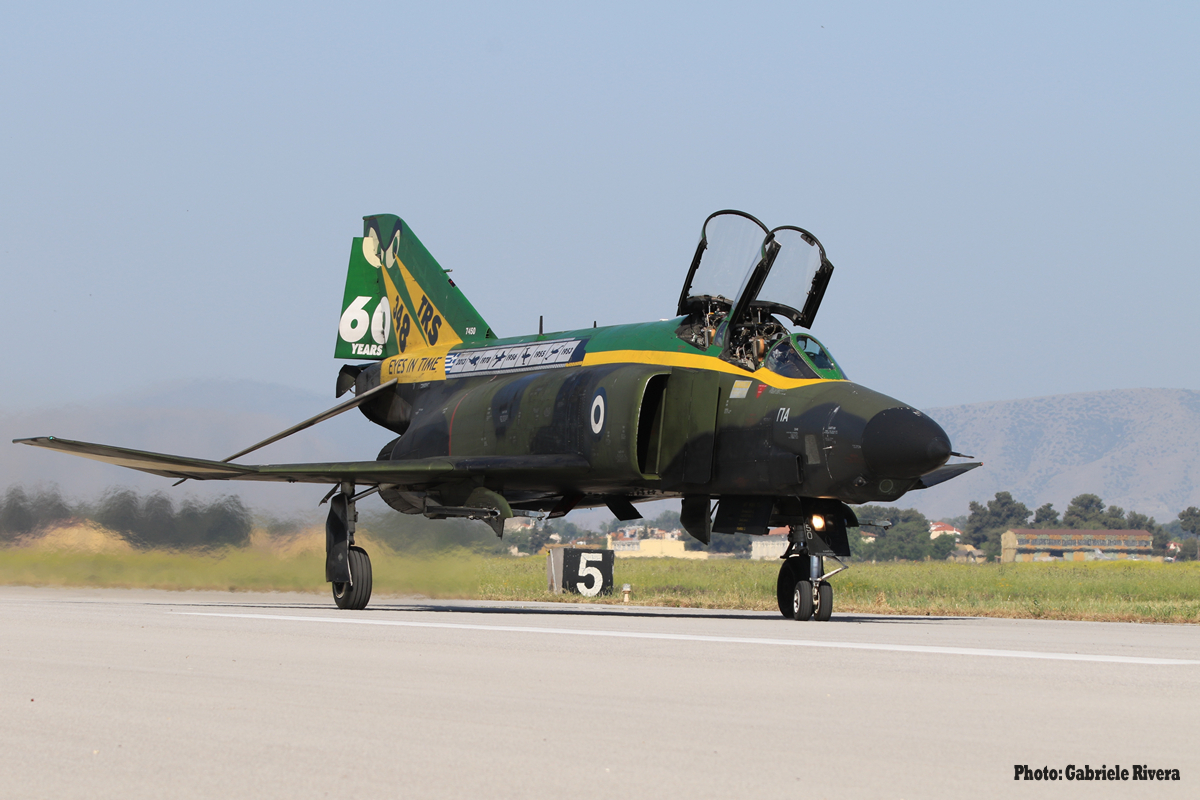
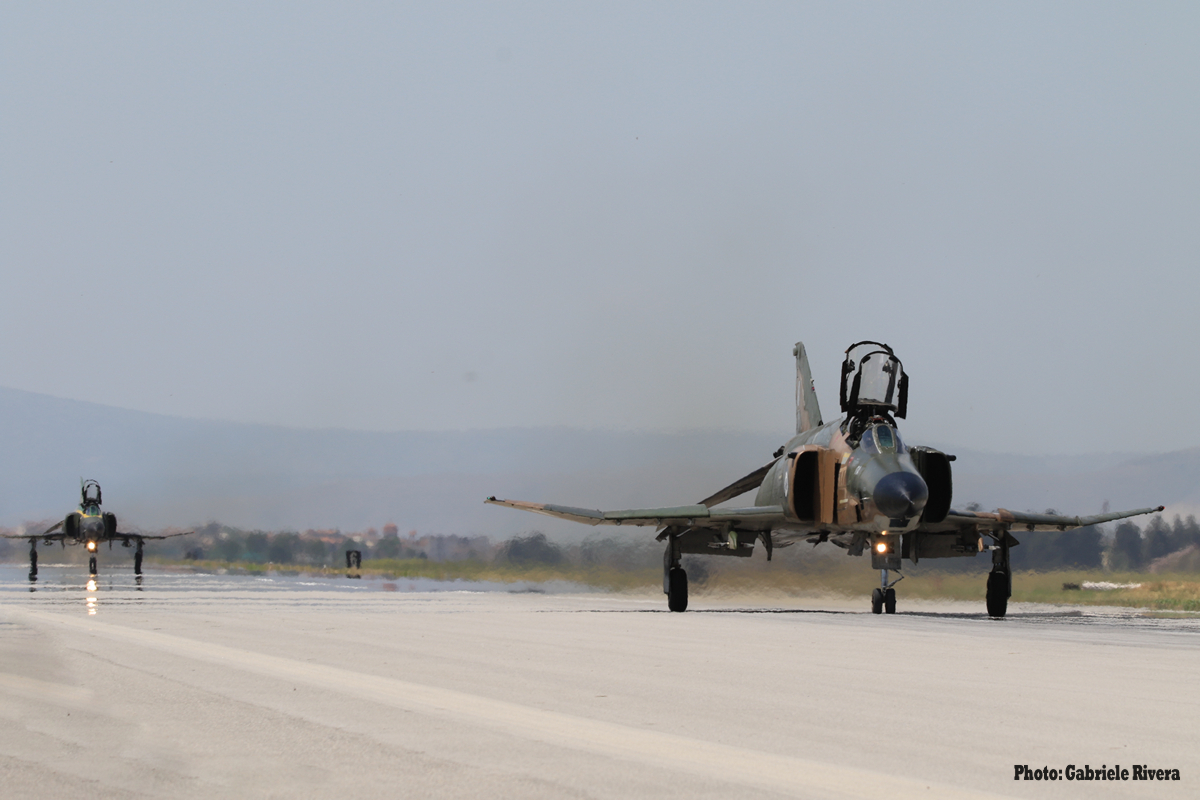
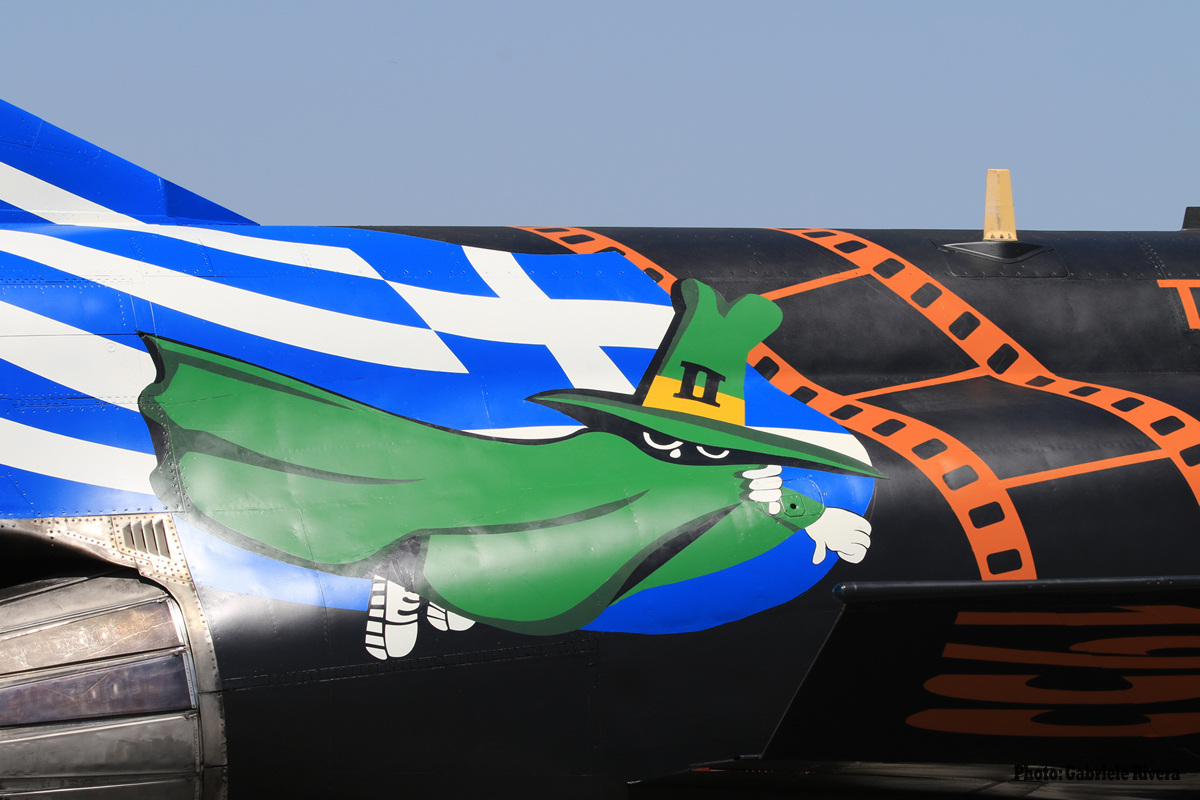
Click on an image below to page or swipe through the gallery:


